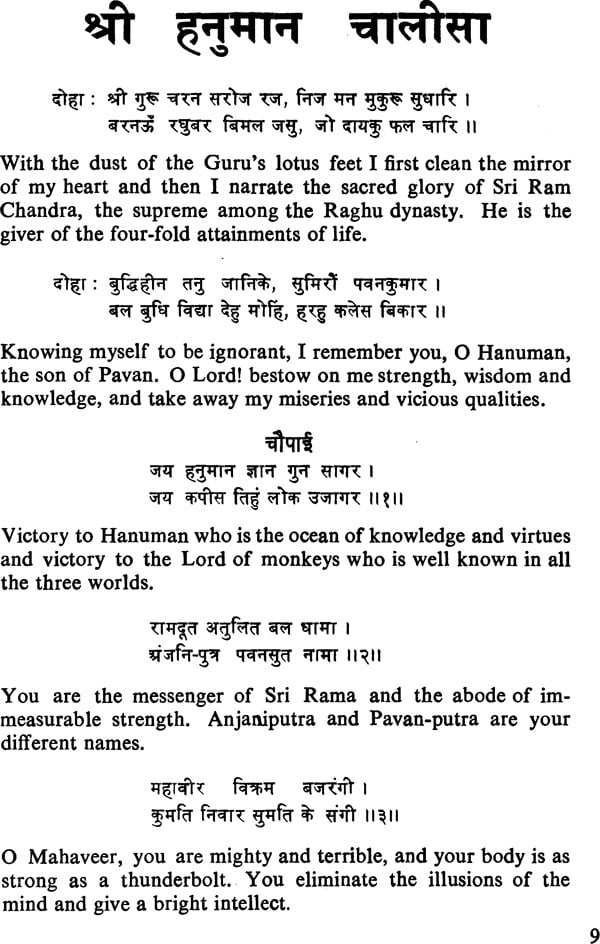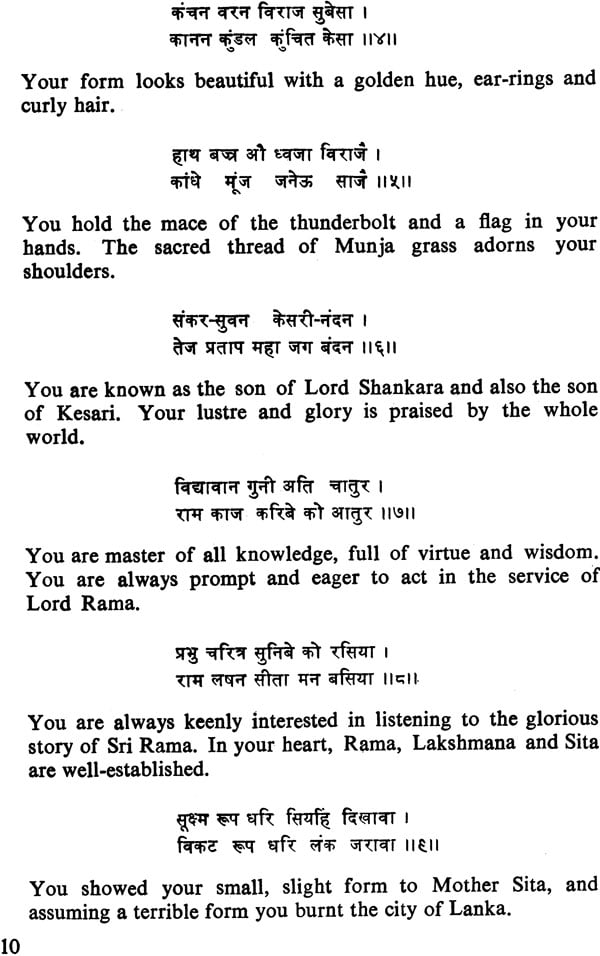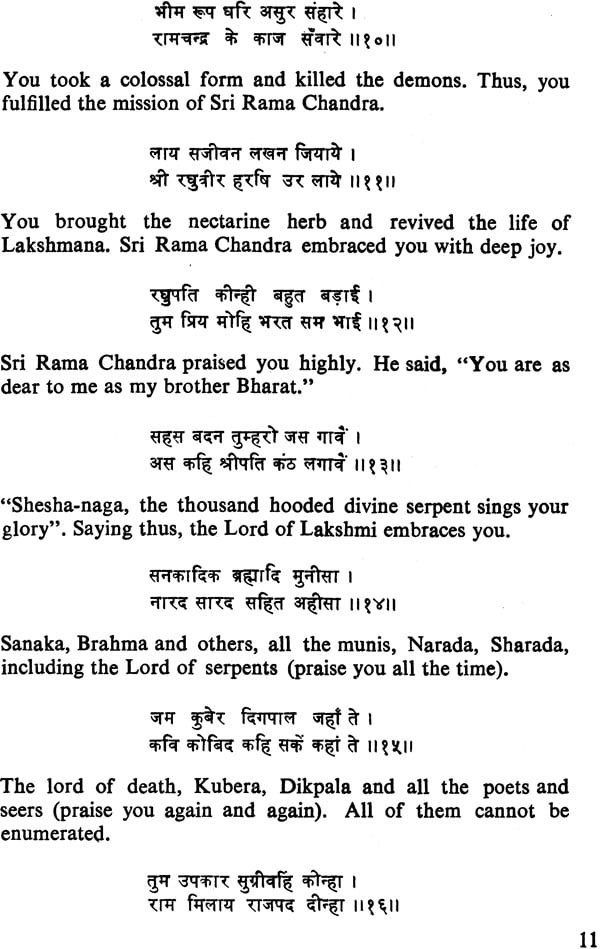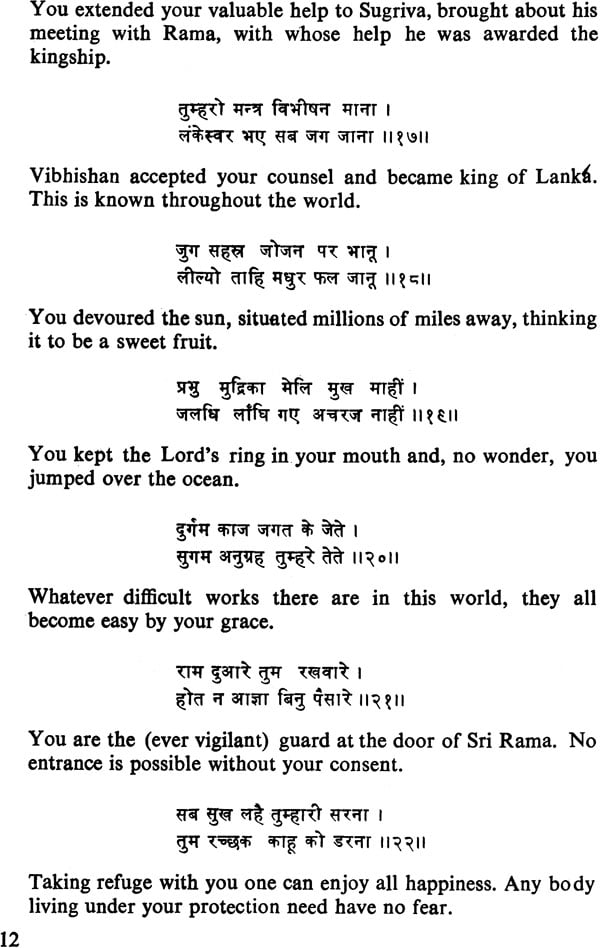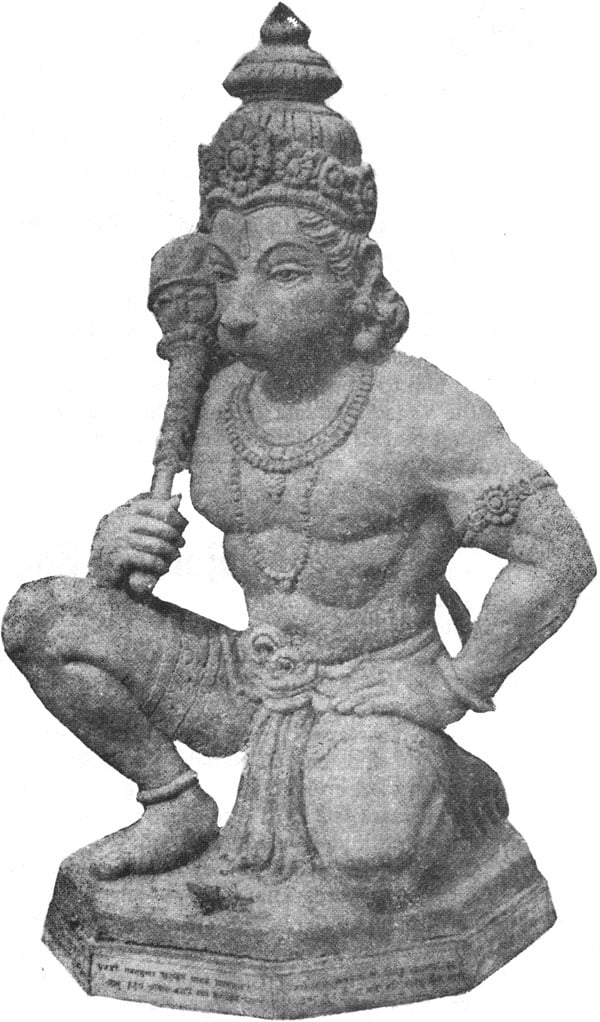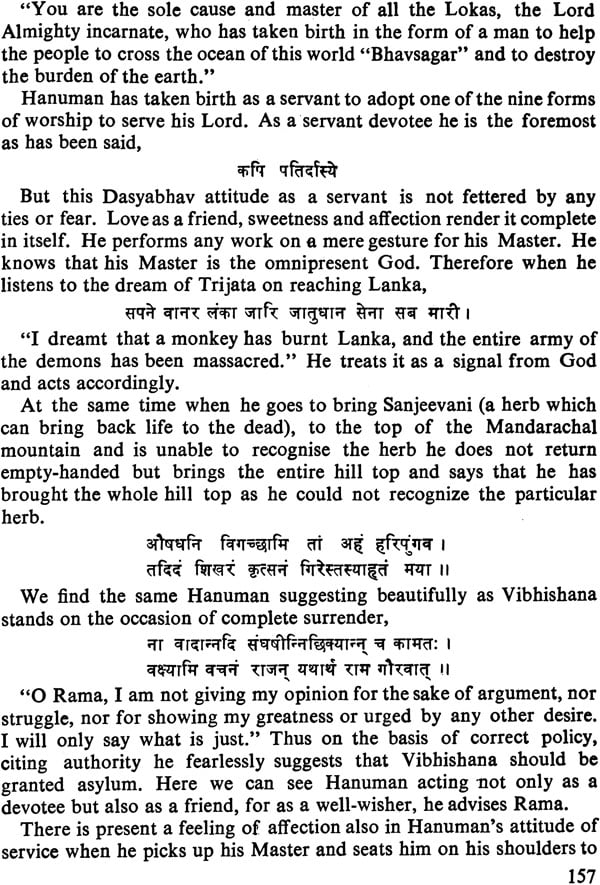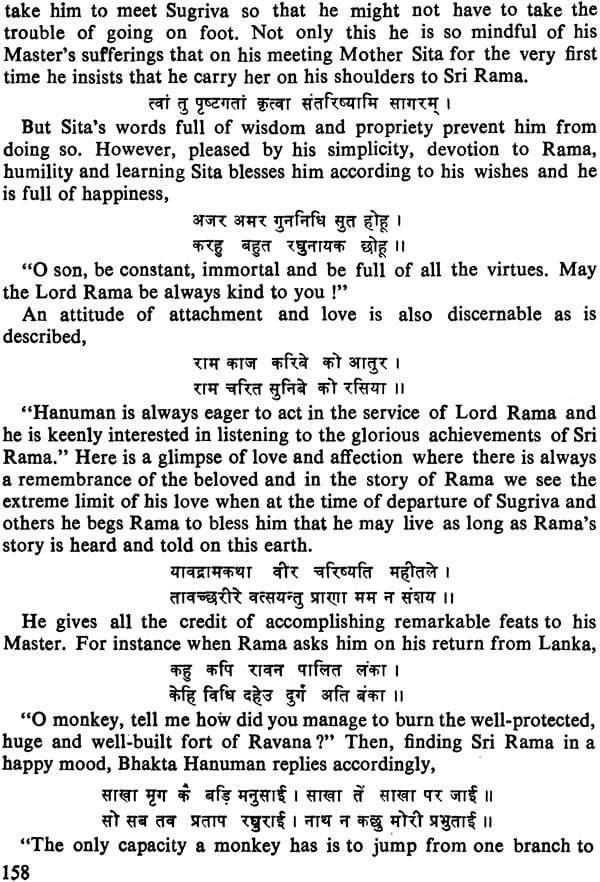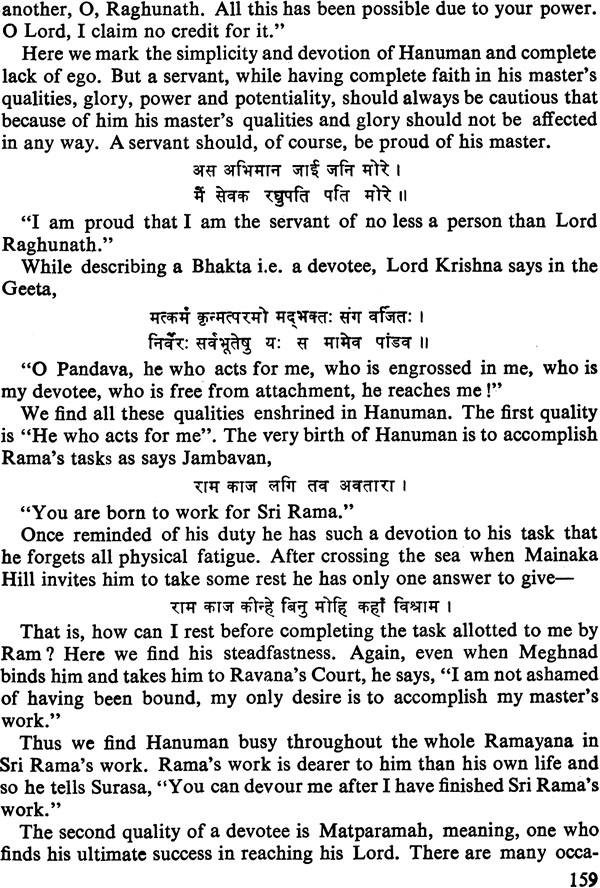
Hanumat Vibhuti
Book Specification
| Item Code: | IDJ664 |
| Publisher: | CENTRAL CHINMAYA MISSION TRUST |
| Language: | English & Hindi |
| Edition: | 2012 |
| Pages: | 178 (Illustrated through in Black & White) |
| Cover: | Paperback |
| Other Details | 8.2" X 5.4" |
| Weight | 290 gm |
Book Description
Ramaya Tubhyam Namah
He supreme cannot be captured in the usual web of words. Therefore, the Hindu scriptures employ a unique strategy using language successfully where language must necessarily fail. This unique feat is achieved by the Masters and Prophets of the scriptures because words have both a direct "meaning" and a content of "suggestiveness". Employing this suggestive content of words, the Rishis had successfully helped their students in appreciating, comprehending and ultimately apprehending the Supreme. In literature, the style is called Mysticism.
Vedic mysticism soaked the minds of the thinkers in India and all their creative art has a touch of mysticism. Hence the distinguishing charm of Indian art and literature. From a village hut-wall, with its apparently crude drawing, to the great frescoes in temples, highly involved sculpturing on the temple-walls, the great and ancient works in Sanskrit, all have the same background melody of a rumbling and tumbling, gushing and pushing stream of mysticism.
The very first literary work in Sanskrit, other than the Vedas, and much earlier than Vyasa, is from the great poet-seer Valmiki, whose work is "Glory of Rama" (Ramayana). Ramayana stands as the link between the Vedic mysticism and the poetic exuberance of classical literature, inaugurated mainly by Vyasa. Ramayana has the wealth of the spiritual truths of the Vedas, packed in a surprisingly sophisticated veneer of mysticism. Yet, it drips on all sides the melody, rhythm, and sheer beauty of poetry at its best.
As a character, Hanuman represents a perfect man of education and culture, proficient and efficient, and ever a go-getter. Nothing seems to be impossible for him. To think is to act for him; to conceive is to achieve. Yet, this beautiful characterization, all along Ramayana, so tenderly both handled and dandled by the sensitive poet Valmiki, has been deliberately wrapped up in the outer anatomical shell of a monkey! Any sensitive student of literature will be compelled to pause for a moment to wonder, "Was it a monkey?" To suggest this question in the mind of the readers, Valmiki himself describes him as, "Is he a man?". The symbolism suggested is evidently clear to all deep students of our Spiritual texts, who are familiar with our cultural diction, and who are trained to be sensitive in Indian traditions of poetry.
Monkeys represent thoughts, the similarity being that both are restless and unsteady. Of all thought, the very minister of Su-greeva, now in his exile, was Hanuman, extremely erudite and scholarly. Yet, this thought-personality cannot bring out its potential might and beauty, albeit serving as the minister to "Self-Control". Knowledge and erudition, with moral restraint and physical control, is the highest from the standpoint of material education, and according to the systems of worldly education. Yet, Valmiki demonstrates that knowledge bows down to Rama, the Spiritual Essence.
From the moment Anjaneya meets with Rama, Ramayana distinctly reveals a mysterious unfoldment of great apparently ridiculous and seemingly insignificant form of a monkey. Such an explosion we watch all down history, demonstrated in a carpenter's son becoming Jesus, or an equally empty Prince Siddhartha rising to the status of a Buddha, or an insignificant student of Calcutta University, Narendra, hatching himself out to become the gracious and dynamic Vivekananda.
However wise and intelligent we may be, even when that wise man has character and self-control, it is not all. Only when these thoughts move, in utter devotion and total loyalty towards "that which revels in everything" (Rama), that all the inherent potentialities divine can get a chance to blossom forth.
Thereafter, as the loyal servant of Sri Rama, the personality of Hanuman unfolds its infinite strength and endless beauty, for all generations to watch, and yet in himself he remains outwardly a va-nara and inwardly a steady and total devotee. Centred in Rama, he acted. For Rama, he achieved. Rama's glory was his only glory. There stands now the puny monkey, larger than life: greater than the greatest, the eternal devotee, his strength, his wisdom, his love, and his all, dedicated totally to Rama. Thereafter we detect the Supreme expressing through this insignificant-looking monkey, making us all wonder, "Is it a man (Va-nara)?" or "Is it a God (Va-deva)?"
Even though Hindus have, down the centuries, been appreciating the glories of Hanuman, nowhere do we find a compilation upon the glories and achievements of this brilliant character. Modern youngsters, though fed upon the Superman of comic literature, still wonder at this wise and dynamic devotee of Rama, represented as a monkey. They rarely come to read the significance in this poetic masterpiece.
I am extremely grateful to the Editor and the authors who have successfully brought out the beauty and strength of the character of Hanuman. Though this was published as a Souvenir during the sacred anointment (Abhishekam), of the Hanuman Murti in Sidhabari, the material was so good that Central Chinmaya Mission Trust Publications Department has rightly decided to perpetuate it in a book form- Hanumat Vibhuti. I also feel extremely grateful for the inspired illustrations made in off-hand, pastel strokes by Madhav Naik. Hanuman seems to have scratched his own pictures through him.
Ramaya Tubhyam Namah
- Swami Chinmayananda
| 1. | Sri Hanuman Chalisa -Translated by P.C. Shukla | 9 |
| 2. | The Personality of Sri Hanuman -Prof. K. Ramachandran Nair | 17 |
| 3. | Hanuman's Devotion to Duty -B. Sundar Lal | 23 |
| 4. | Hanuman -Swami Krishnananda | 33 |
| 5. | Hanuman, the Ideal -Br. Vivek Chaitanya | 35 |
| 6. | Anjaneya -Br. Paramartha Chaitanya | 37 |
| 7. | Hanuman-Man and Superman -Vidyavachaspati V. Panoli | 41 |
| 8. | Sri Hanuman -Mrs. Ramanam | 45 |
| 9. | Ambassador of Goodwill -Uma Shankar Varma | 53 |
| 10. | Hanuman's Presence of Mind -Br. Venkatadri | 59 |
| 11. | The Monkey-God -K.P. Ramunni Menon | 62 |
| 12. | The Concept of Hanuman- Dr. R. Nagaswamy | 67 |
| 13. | Worship of Hanuman -Ajit Sukhatankar | 72 |
| 14. | Hanuman is Indian Philosophy -Br. Munindra Panda | 75 |
| 15. | The Mystic Monkey God -B.S. Satyanarayana | 83 |
| 16. | Hanuman in Search of Peace -Br. Omkar Nath | 94 |
| 17. | The First Meeting -V. Damodara Menon | 99 |
| 18. | Hanuman, the Eloquent -Anantha Narayana (Mani) | 105 |
| 19. | Hanuman Down the Ages -Swami Keshavananda Saraswati | 113 |
| 20. | Hanuman, the Karma Yogi -Br. Niraj Misra | 119 |
| 21. | The Jnani -Br. Vinayak Rao | 123 |
| 22. | Ode to Hanuman -Br. Chandrasekhar Hegde | 129 |
| 23. | Hanuman, The Envoy -Br. Santhanam | 131 |
| 24. | Jewel of Ramayana -R. Varadarajan | 137 |
| 25. | The Greatness of Hanuman -Anantha Narayan (Mani) | 141 |
| 26. | Swamiji -Meenaz Kassam | 147 |
| 27. | Chinmaya Mission -Jagdeesh Prasad | 148 |
| 28. | Sankatmochan Hanumansashtak (Hindi) | 153 |
| 29. | Sri Rama Stuti (Hindi) | 154 |
| 30. | Bajarang Bali -Brahmacharini Usha | 155 |
| 31. | The Humility of Hanuman Sheela Sharma | 163 |
| 32. | The Blossoming of a Bhakta -Swami Parameswarananda Saraswathi | 167 |
| 33. | The Self-confidence of Hanuman -Swami Gnanananda Saraswathi | 172 |
| 34. | Mighty Hanuman -C.S.K. Menon | 175 |
